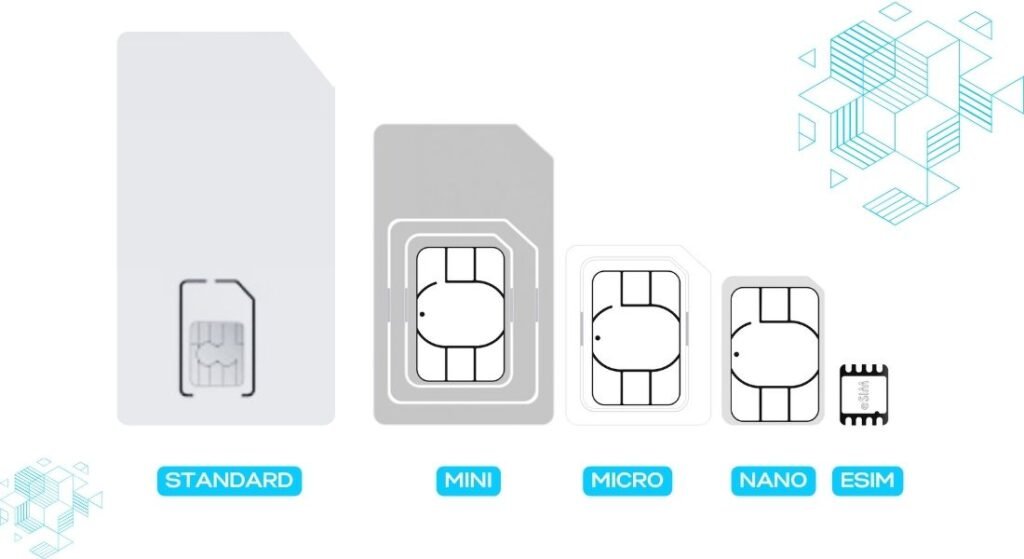Introduction
Ever wondered about that tiny piece of plastic—or the lack thereof—in your phone that connects you to the world? SIM technology has come a long way, and understanding its evolution is crucial for making informed decisions. From the standard SIM to the Nano SIM and the now-ubiquitous eSIM, the options can be confusing. This post aims to clarify the differences, advantages, and disadvantages of each type, ensuring you know which SIM best suits your needs.

Understanding SIM Cards: The Basics
A SIM card, or Subscriber Identity Module, is a portable memory chip that connects your mobile device to a carrier’s network. It’s what allows you to make calls, send texts, and use mobile data. Each SIM card contains your phone number and stores crucial data, including your IMSI (International Mobile Subscriber Identity) and ICCID (Integrated Circuit Card Identifier). Mobile networks use this information to verify you as a subscriber and grant you access to their network.
The technology has changed significantly since the first SIM card. Here’s a quick look at how SIM cards have evolved:
- Full-Size SIM: The original SIM card, launched in 1991, was about the size of a credit card.
- Mini SIM: Introduced in 1996, the Mini SIM was significantly smaller.
- Micro SIM: This version further reduced the size, trimming away more plastic.
- Nano SIM: The current standard for physical SIM cards, the Nano SIM is compatible with most modern devices.
- eSIM: The game-changer, introduced in 2016, is a fully digital SIM card built into a device’s hardware.
📱 Using an iPhone or Pixel? You might already be eSIM-ready. Learn how to install an eSIM in under 2 minutes and skip the plastic chip forever
Nano SIM: The Current Physical Standard
The Nano SIM, or 4FF (fourth form factor), measures just 12.3mm x 8.8mm x 0.67mm. It requires a physical SIM card slot and allows for sleeker device designs due to its compact size.
Pros of Using a Nano SIM
- Wide Compatibility: Nano SIMs work with many smartphones and mobile devices.
- Removable and Transferable: You can easily switch providers and devices.
- No Carrier Lock-in: Easily switch between different mobile service providers.
- Offline Savior: Being a physical object, you can easily remove and transfer a Nano SIM from one device to another.
- No Technical Hurdles: They are simple to insert and remove, which is beneficial for those not tech-savvy.
Cons of Using a Nano SIM
- Small Size: They can be tricky to handle and easy to lose or damage.
- Managing Multiple Cards: It can be cumbersome when traveling frequently.
- Roaming Charges: You might incur expensive charges if you’re not on a prepaid plan.
- Security Concerns: They are vulnerable to theft and SIM card scams.
- Environmental Footprint: The manufacturing process involves plastics and metals, contributing to carbon emissions.
eSIM: The Digital Revolution
An eSIM, or embedded SIM, is a SIM card that is built right into your gadget, so you don’t need a separate card. Activation is digital, typically via a QR code or a carrier profile download.
Pros of Using an eSIM
- Smaller Size: eSIMs free up space inside the device for other components.
- Embedded: They can’t be lost, stolen, or damaged.
- Easier to Switch Networks: You can download an eSIM plan and connect instantly.
- No Roaming Fees: You pay for the data you need without hidden fees.
- Store Multiple eSIM Profiles: This provides more freedom and flexibility.
- Safer: They are nearly impossible for scammers to swap or clone.
- Travel Like a Pro: You can easily switch between carriers and change plans digitally.
- The Internet of Things Revolution: They can be used on various devices like smartwatches and smart home devices.
Cons of Using an eSIM
- Not as Widely Available: eSIM is still a relatively new technology.
- Carrier Control and Lock-in: eSIMs can sometimes be locked to a specific carrier.
- Technical Hurdles: Not all devices are equipped to support eSIM technology.
- Limited Offline Options: An internet connection is required for activation and setup.
- Switching Devices Gets Tricky: An eSIM can usually only be installed once.
eSIM vs. Nano SIM: Key Differences
Understanding the key differences between eSIM and Nano SIM can help you decide which is best for you.
- Form Factor and Size:
- Nano SIM: 12.3mm x 8.8mm x 0.67mm.
- eSIM (MFF2): 5mm x 6mm x 1mm.
- eSIMs are significantly smaller, which allows for sleeker designs.
- Installation and Flexibility:
- Nano SIM: Requires physical insertion.
- eSIM: Activation and switching are managed via software.
- Device Compatibility:
- Nano SIM: Widely compatible with many devices.
- eSIM: Increasingly common in newer devices like iPhones and Google Pixel phones.
- Convenience for Travelers:
- Nano SIM: Often requires purchasing local SIM cards.
- eSIM: Can store multiple carrier profiles and switch via software.
- Security and Reliability:
- Nano SIM: Can be lost, damaged, or stolen.
- eSIM: More secure because they cannot be easily removed.
- Cost:
- Nano SIM: Lower installation costs.
- eSIM: Higher initial costs but potential long-term savings.
- Durability and Lifespan:
- Nano SIM: Device lifespan may necessitate SIM replacements.
- eSIM: Long-lasting and can potentially last for the device’s lifetime.
🔁 Want to use both eSIM and a physical SIM together? Here’s how to make it work.
Dual SIM Phones: Combining Nano SIM and eSIM
Many modern devices are equipped with Dual SIM technology, allowing you to use both a Nano SIM and an eSIM simultaneously. This setup allows you to:
- Use one number for business and another for personal calls.
- Add a local data plan when traveling.
- Have separate voice and data plans.
- Seamlessly switch between carriers without needing a new SIM card.
The convenience of switching between different cards and networks, combined with sleeker phone designs, makes Dual SIM phones an attractive option.
🎯 Still wondering what eSIM is, exactly? Here’s a complete beginner’s guide to eSIM to help you fully understand the concept.
How to Switch Carriers with eSIM
Switching carriers with eSIM technology has simplified the process. You can change carriers directly on your device without needing a physical SIM card. Here’s a simple step-by-step guide:
- Check if your phone is eSIM-ready.
- Download the carrier’s app.
- Choose your plan.
- Set up the eSIM by scanning a QR code or entering the details manually.
Addressing Common eSIM Issues and Troubleshooting
While eSIMs offer numerous benefits, issues can arise.
- Activation Problems: If you encounter activation errors or the QR code doesn’t work, contact your carrier for assistance.
- Transferring eSIMs: Transferring an eSIM to a new device can sometimes be problematic. Ensure your carrier supports online transfers or be prepared to visit a physical store.
- Resetting iPhones with eSIMs: After resetting your iPhone, you may need to contact your carrier to reactivate your eSIM.
- M2M eUICC: M2M (machine-to-machine) eUICCs are designed for IoT devices and can be updated over the air, offering greater flexibility.
Security Considerations
Security is a key concern when choosing between Nano SIM and eSIM.
- Nano SIM Security Risks: Physical theft can lead to unauthorized access, and SIM swapping scams are a threat.
- eSIM Security Advantages: The embedded nature of eSIMs makes them harder to steal or clone, reducing the risk of physical tampering.
To enhance your security, enable device encryption, use strong passwords and PINs, and be cautious of phishing attempts.
The Environmental Impact
The environmental impact of SIM technology is an important consideration.
- Nano SIMs: The manufacturing and distribution of physical SIM cards involve environmental costs and generate waste from discarded cards.
- eSIMs: eSIMs have the potential to reduce waste by eliminating the need for physical cards and streamlining logistics, which reduces carbon emissions.
eSIMs in IoT (Internet of Things)
eSIMs offer numerous benefits for IoT devices.
- Smaller size for compact devices.
- Durability and resistance to extreme conditions.
- Long lifespan, reducing the need for replacements.
Suitable IoT Applications include:
- Smart Buildings
- Fleet Management
- Point of Sale systems
- EV Charging
- Agriculture
- Energy
Future Trends in SIM Technology
The adoption of eSIM technology is expected to rise significantly as manufacturers incorporate eSIMs into new devices and potentially phase out traditional SIM cards. Advancements in 5G and IoT will further drive the adoption of eSIMs. There is also the potential for new SIM form factors and entirely new approaches to mobile network connectivity.
❓ Have more questions about eSIMs? Check out our full eSIM FAQ here for all the nitty-gritty details.
Conclusion
In the battle of SIM vs. Nano SIM vs. eSIM, the best choice depends on your individual needs and preferences. Nano SIMs offer wide compatibility and ease of use, while eSIMs bring modern convenience and flexibility.
If you value convenience, security, and digital efficiency, an eSIM is a forward-looking choice. However, if you prefer the traditional approach with the freedom to easily switch carriers, a Nano SIM might be more suitable. Stay informed and embrace the future of mobile technology!
✈️ Travel smarter, not harder. Find out which eSIM plan fits your trip best — no roaming fees, no lines, just fast, reliable internet wherever you land.








